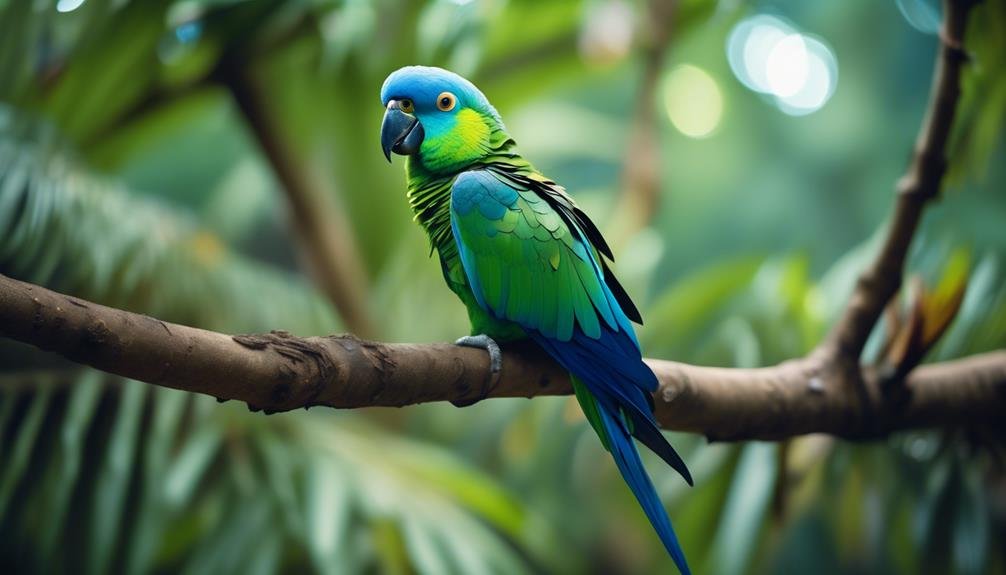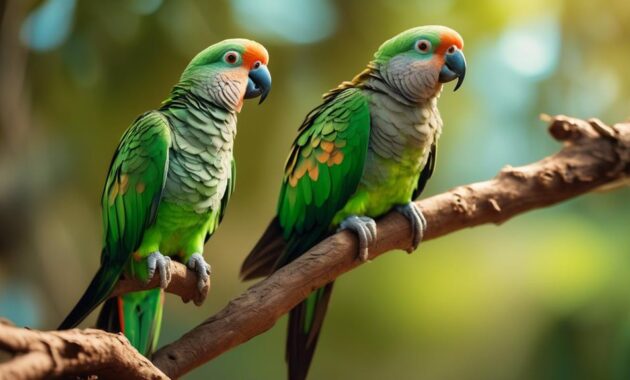
Imagine having a companion who is not only captivating but also possesses a rare combination of intelligence and charm. Picture a bird with vibrant green plumage, accentuated by a striking blue patch on its head.
This is the Blue Naped Parrot, a captivating creature that has fascinated bird enthusiasts for years. But what sets this parrot apart from others? What makes it such a captivating companion?
In this article, we will uncover the intriguing characteristics and unique qualities of the Blue Naped Parrot, leaving you eager to learn more about this rare and intelligent avian friend.
Key Takeaways
- Blue Naped Parrots have a relatively small size compared to other parrot species, with a length of approximately 12 inches and an average weight of half a pound.
- They have a long lifespan of 40-60 years and are known for their hardy health and adaptability.
- Blue Naped Parrots are highly sought after as pets due to their intelligence and inquisitive nature.
- Providing optimal living conditions, exercise, a balanced diet, and mental stimulation is important for their longevity and overall health.
Size and Lifespan
Blue Naped Parrots have a relatively small size compared to other parrot species, measuring approximately 12 inches in length. With their slender build and powerful head and beak, these parrots weigh around half a pound on average.
Remarkably, they’ve a long lifespan of 40-60 years and are known for their hardy health and adaptability. Hand-reared birds, in particular, are easy to care for and bond with. To ensure their longevity and overall health, optimal living conditions, exercise, a balanced diet, and mental stimulation are essential.
These intelligent and inquisitive parrots are highly sought after as pets. Their mainly green plumage, with a dark green head and a large light blue patch, makes them visually captivating. With their docile temperament, they’re moderately quiet and have the ability to mimic and repeat common words.
Blue Naped Parrots are suitable for living in spacious apartments, making them an excellent choice for a captivating companion.
Bird Species and Characteristics

Blue Naped Parrots are highly sought after as pets due to their distinct characteristics that set them apart from other parrot species. They belong to the parrot family and are a unique species native to the Philippines. They are closely related to the Great-Billed Parrot and Alexandrine Parakeet.
These beautiful birds have mainly green plumage, with lighter shades of green on their chest and belly. Their dark green head features a large light blue patch on top, and their wings have thick yellow edges, creating a subtle pattern. The bright red beak is one of their most prominent features.
Blue Naped Parrots are moderately quiet birds with a docile temperament. They have the ability to mimic and repeat common words, and can be taught to repeat short phrases with patience. They also chatter quietly to themselves, attempting to mimic human speech.
Colors

The plumage of Blue Naped Parrots showcases a vibrant combination of greens, highlighted by a striking light blue patch on their head. Their feathers are mainly green, with lighter shades on their chest and belly.
Their dark green head features a large light blue patch on top, making it a distinctive and eye-catching feature. The wings are also dark green, with thick yellow edges that create a subtle pattern. One of their most prominent features is their bright red beak.
These colorful markings make Blue Naped Parrots a visually captivating species. Their vibrant colors add to their overall charm and beauty, making them a sought-after companion for bird enthusiasts.
Sounds and Vocalization

As we shift our focus to the sounds and vocalization of Blue Naped Parrots, it becomes evident that their docile temperament and moderate vocalization make them an intriguing companion for bird enthusiasts.
Here are three key points to consider:
- Moderate Vocalization: Blue Naped Parrots aren’t overly vocal or excitable. They tend to be relatively quiet birds, making them suitable for living in apartments or shared spaces where excessive noise may be a concern.
- Mimicking Abilities: These intelligent parrots have the ability to mimic and repeat common words. With patience and training, they can be taught to repeat short phrases, making them interactive and entertaining companions.
- Chattering to Themselves: Blue Naped Parrots also engage in quiet chattering, attempting to mimic human speech. This behavior adds to their charm and showcases their curiosity and desire for social interaction.
Suitable Living Environment

Creating a suitable living environment is crucial for the overall health and well-being of Blue Naped Parrots. These intelligent birds thrive in spacious apartments, thanks to their relatively small size. To ensure their optimal health, it’s essential to provide them with the right conditions.
Blue Naped Parrots require ample space to move around and exercise. They also need a balanced diet consisting of fresh fruits, vegetables, and high-quality pellets. Mental stimulation is vital for these inquisitive birds, so providing toys, puzzles, and social interaction is important.
Additionally, maintaining a clean and well-ventilated living space is essential to prevent respiratory issues. By creating a suitable living environment that meets their physical and mental needs, you can ensure that your Blue Naped Parrot remains happy and healthy for years to come.
Diet and Nutrition

To ensure the optimal health and well-being of your Blue Naped Parrot, it’s important to understand their dietary needs and provide them with a nutritionally balanced diet. Here are three key points to consider:
- Fresh Fruits and Vegetables: Include a variety of fruits and vegetables in your parrot’s diet, such as apples, grapes, carrots, and leafy greens. These provide essential vitamins, minerals, and antioxidants.
- High-Quality Pellets: Choose high-quality pellets specifically formulated for parrots. These pellets are a convenient way to ensure your parrot receives all the necessary nutrients, including proteins, carbohydrates, and fats.
- Limited Seeds and Nuts: While seeds and nuts can be offered as occasional treats, they shouldn’t make up the majority of your parrot’s diet. Too many seeds and nuts can lead to nutritional imbalances and obesity.
Social Behavior and Bonding

Blue Naped Parrots are highly social creatures, forming strong bonds with their human companions. They thrive on social interaction and enjoy spending time with their owners. These parrots have a natural curiosity and intelligence, making them excellent companions. They’re known to be affectionate and can develop a deep bond with their human family members.
Blue Naped Parrots enjoy being included in family activities and can become quite attached to their primary caregivers. It’s important to give them plenty of attention and stimulation to keep them happy and prevent boredom. Regular interaction, playtime, and positive reinforcement training can help strengthen the bond between you and your Blue Naped Parrot, ensuring a fulfilling and rewarding companionship.
Training and Enrichment

After developing a strong bond with your Blue Naped Parrot, it’s important to focus on their training and enrichment to ensure their continued growth and well-being. Here are three key aspects to consider:
- Basic Training: Start with simple commands like ‘step up’ and ‘stay,’ using positive reinforcement techniques such as treats and praise. Gradually introduce more advanced commands to stimulate their intelligence and problem-solving skills.
- Socialization: Expose your parrot to different environments, people, and other animals to help them become well-adjusted and confident. Encourage interactions with toys, puzzles, and other engaging activities to keep their minds active and prevent boredom.
- Enrichment: Provide a variety of toys, including puzzle toys, chew toys, and foraging toys, to keep your parrot mentally stimulated. Rotate their toys regularly to maintain their interest. Additionally, consider introducing natural perches and branches in their environment to encourage climbing and exercise.
Health Care and Common Diseases

When caring for your Blue Naped Parrot, it’s crucial to prioritize their health care and be aware of common diseases they may be susceptible to. Regular veterinary check-ups are essential to monitor their overall health and detect any potential issues early on.
Blue Naped Parrots are prone to respiratory infections, so it’s important to maintain a clean and well-ventilated living environment. Other common diseases include feather plucking, which can be a sign of stress or boredom, and beak and feather disease, a viral infection that affects the bird’s immune system.
Providing a balanced diet, regular exercise, and mental stimulation can help prevent these diseases and ensure your Blue Naped Parrot remains healthy and happy.
Frequently Asked Questions
How Do Blue Naped Parrots Communicate With Each Other in the Wild?
Blue Naped Parrots in the wild communicate through a variety of vocalizations, including calls, squawks, and soft chattering. They use these sounds to establish territory, attract mates, and communicate with their flock members.
Are Blue Naped Parrots Prone to Any Specific Health Conditions or Diseases?
Blue Naped Parrots are generally hardy and adaptable, but like any living creature, they can be prone to specific health conditions or diseases. Regular vet check-ups and a healthy lifestyle can help prevent and manage these issues.
Can Blue Naped Parrots Be Trained to Perform Tricks or Participate in Agility Courses?
Yes, Blue Naped Parrots can be trained to perform tricks and participate in agility courses. With patience and positive reinforcement, you can teach them to do various activities that showcase their intelligence and agility.
How Do Blue Naped Parrots Interact With Other Pets or Animals in a Household?
Blue Naped Parrots generally have a friendly nature and can interact well with other pets or animals in a household. With proper introductions and supervision, they can form positive relationships and coexist peacefully.
What Are Some Common Signs of Illness or Distress in Blue Naped Parrots That Owners Should Be Aware Of?
If your blue naped parrot is showing signs of illness or distress, pay attention to changes in appetite, behavior, or appearance. Consult a veterinarian if you notice symptoms like lethargy, loss of feathers, or abnormal droppings.
What Makes the Blue Naped Parrot a Captivating Companion?
The stunning golden shouldered parrot, also known as the blue-naped parrot, is a captivating companion due to its vibrant plumage and playful personality. With its intelligent and social nature, this parrot makes for a delightful pet that brings joy and color to any household.
Conclusion
In conclusion, the rare and intelligent Blue Naped Parrot is a captivating companion that brings both beauty and charm to any home.
With their slender build, striking blue patch on the head, and docile temperament, these parrots are highly sought after as pets. They have the ability to mimic and repeat common words, adding a touch of charm to daily interactions.
With the right care, attention, and suitable living environment, these captivating companions can bring joy and companionship for many years to come.




